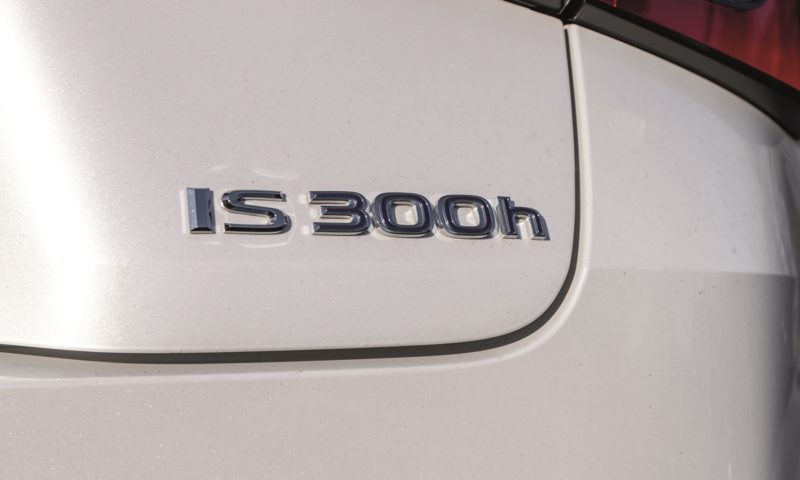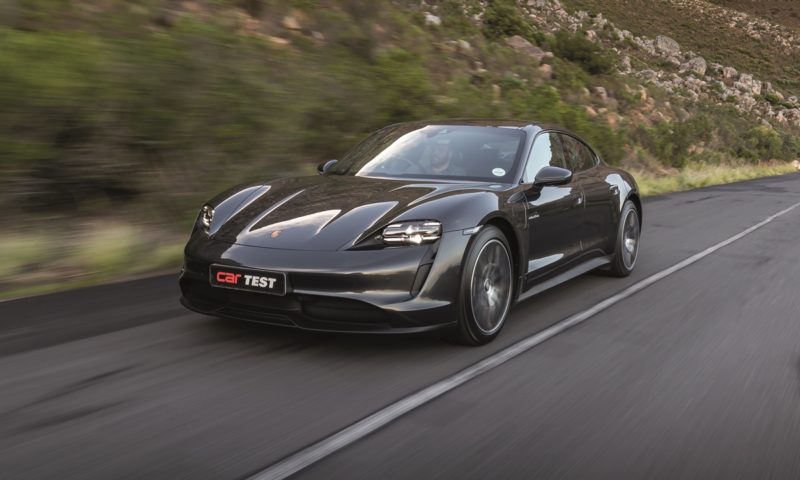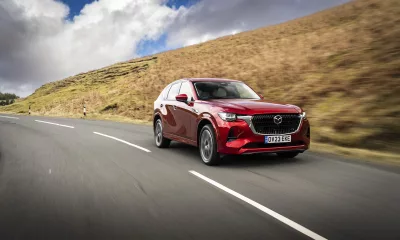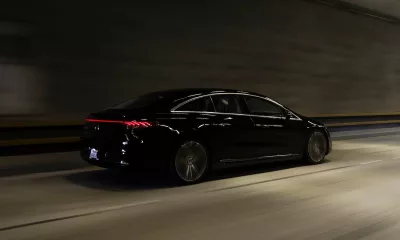This test was devised to go beyond evaluating the consumption – fuel in the case of three vehicles, energy for the fourth – of four brand-new saloons, driven on the same route at the same time in identical conditions. Beyond the simple question of which is the most economical from A to B, additional answers we wanted answered were: is the modern downsized turbopetrol as efficient as claimed? Is diesel technology in decline? Does a hybrid really provide the best of both worlds with its dual-energy drivetrain? And, in light of ever-improving battery technology, is a pure EV a viable option despite the hefty initial outlay? We’ll also assess how the driver should alter behaviour to get the most out of each drivetrain in a hypermiling sense. Many questions, so let’s get some answers …
Ah yes, we must do this scientifically, of course, so we’ve set out a real-world route that mimics the rolling road dynamometer test each new car undergoes to ascertain its claimed/combined consumption figure. For reference, in laboratory conditions this test consists of an urban cycle of 4 km, driving at an average speed of 20 km/h, incorporating vehicle stops and reaching a maximum speed of 50 km/h. The extra-urban cycle of 7 km brings the maximum speed up to 120 km/h, at an overall average of 63 km/h. That’s an average speed of 41,5 km/h if you combine both legs. To replicate this, we plotted a loop from the Cape Town CBD towards the southern suburbs along the bustling Main Road in midday traffic (urban), continuing to Simonstown where the test switches to extra-urban, climbing up to Smitswinkel and around
the rest of the peninsula via Chapman’s Peak, before finishing back in the city bowl. Neat, tidy and scientific.
The 120 km route runs along what was once known as the ARCPR or “All Round Cape Peninsula Road” and is exactly half urban and half extra-urban for the fairest reflection of real-world economy. The ARCPR – constructed between 1913 and 1922 – was the work of the province’s chief administrator,
Sir Frederic De Waal (of De Waal Drive fame) who, along with engineer’s William West, Charl Marais and Robert Glenday, were the first to conquer the seemingly impossible geology of Cape granite rock to create one the Western Cape’s and the world’s most scenic roads.

Not that the ARCPR in 2021 was particularly scenic as we turned onto Main Road Woodstock and began working our way through the trickle-like midweek malaise of Golden Arrow buses and minibus taxis. The BMW 330i has a free-spinning 2,0-litre turbo-petrol and its only real hope of matching the eco-worthiness of the others here was to simply disengage its turbocharger all together. With 190 kW/400 N.m on tap, it minced the other two internal combustion engine (ICE) cars in a straight line with a sub-6,00 second zero to 100 km/h sprint, but we weren’t interested in acceleration and tractability; rather we were in Eco Pro mode and wanted to know if BMW’s claim of 6,40 L/100 km is in any way attainable in the real world.
Interestingly, the BMW’s first and biggest consumption spike came right from the off when it shot to 8,70 L/100 km with the motor and ancillaries warming up as we traipsed straight into heavy Woodstock traffic. At the same time, in the same conditions, the hybrid Lexus sat at 4,70 L/100 km, highlighting the ever-improving energy efficiency of hybrid powertrains. From this initial peak, the BMW’s figures showed steady, consistent improvement; 7,50 L/100 km by the time we cleared the city, dropping to 6,90 L/100 km when the road opened up, before settling on 6,70 L/100 km in the final tally. It was not as frugal as claimed, in fact, it was the only vehicle not to equal or best claimed. Yet, considering the performance, being only 0,30 L/100 km off is still mighty impressive. The BMW was least happy in urban driving and would’ve benefited the most from thinner traffic in the initial phase of the test and a route that had a higher average speed.
We should also mention – alluding to where each drivetrain shines and how it makes the driver respond – the 330i was so happy to zip ahead in the extra-urban cycle with the help of its coasting function, that we had to slow down so as not to corrupt the results with an average speed that was too high.
Have you noticed that since the #dieselgate scandal, the quoted fuel economy for diesel-powered cars – when manufacturers are brave enough to put them on sale – isn’t as impressive as it was a few years ago? It’s as if diesel’s fuel-saving abilities peaked in the last decade and with the wholesale shift to EVs, manufacturers are unwilling to put further R&D money behind what appears to be a dying technology. It’s a shame really because many South Africans are still enamoured with the great economy and loping torque of oil burners.

Offered in either Coupé or Sportback guise, one such vehicle is the A5 40 TDI. Audi can sell you a front-wheel-drive A4 35 TDI with 110 kW/320 N.m, but the power and torque of the up-tuned 2,0-litre turbodiesel we have here were more in keeping with the profile of this test, even if the engine itself was conspicuously clattery compared to the others.
At R869 000 (R884 500 for the more practical Sportback), the A5 TDI is a touch more affordable than the Lexus hybrid but nearly R100k dearer than the quicker and more powerful BMW 330i. This may make the Audi seem tough on the wallet at first glance but it should be remembered that both Germans do need a few optional extras to reach the same spec level as the svelte Lexus. Nevertheless, out on our test route, the price gulf between these petrol, diesel and hybrid combatants was not glaringly obvious.
In the urban segment where the Lexus was in its element at 4,70 L/100 km, while the Beemer indulged at 8,70 L/100 km, the turbodiesel was quaffing at a rather thirsty 8,30 L/100 km. Even considering it might’ve achieved a better initial fuel consumption if the Audi’s stop-start system wasn’t having such an off day – engaging irregularly during the test, and sometimes not at all – that’s only 0,30 L/100 km less than the turbopetrol BMW. See what we mean about ICE R&D? A decade ago, the gap in consumption between diesel and petrol would have been larger.
True to form, by the time the convoy broke free of slow-moving traffic around about Westlake and reached Smitswinkel, the cruise-happy A5 TDI showed the biggest improvement of the test and dropped its average consumption to 6,90 L/100 km. From there, it clawed back to 6,50 L/100 km and finally settled on 6,10 L/100 km to best its claimed/combined figure. Just. A good result for the unfancied diesel perhaps. Although, I know some of the late adopters among us were hoping the TDI could pull off an upset win against the battery-electric brigade. Alas, it was not to be on this occasion.
As we’ve just witnessed from our two pure ICEs, there’s good reason to go hybrid these days. Dual-energy cars don’t use as much fuel, produce less CO2, are quieter in EV mode and – thanks to the steady advancement of battery technology – can rack up additional mileage off the battery that conventional ICEs cannot. If you choose a good one, like the IS 300h we have here, they’re subject to less tax because the CO2 emissions don’t exceed the 120 g/km threshold by much.

Unfortunately, unlike in Europe and the UK, there are no tax grants or money-back schemes for hybrids/EVs in SA, so a hybrid is not quite as tempting a prospect as it might be elsewhere. Nevertheless, on our test route, the Lexus did provide an intriguing mix of performance (when the batteries were fully charged), fuel economy, luxury and comfort. Its claimed sprint time from standstill to 100 km/h of 8,70 seconds places it in the quick-enough category and in the urban portion of the route, its reliance on the electric-hybrid function kept average fuel consumption impressively low. Unsurprisingly, beyond the city limits – with its batteries depleted and average speed rising – the Lexus’ consumption did the opposite of the ICE competitors and increased as it ran more often than not on the four-cylinder petrol engine. However, we were still thoroughly impressed that average consumption never exceeded 5,50 L/100 km at its thirstiest, before settling on a final figure of 5,30 L/100 km when we alighted back in the CBD.
Thanks to improved battery regeneration on the move in the final half of the test, the Japanese luxury hybrid managed to best its claimed/combined figure by
0,20 L/100 km. In part, you can thank the continuously variable transmission that is most at home in urban conditions and doesn’t encourage hasty driving, shall we say; although the IS was pleasingly quick in short bursts in traffic when electric assistance from the batteries was available. That said, the IS 300h is best enjoyed in Eco mode, travelling in as relaxed a manner as possible, soaking up the opulence.
As the sole EV representative in our efficiency experiment – and a Porsche, no less – a crushing weight of expectation was dropped on the Taycan’s shapely shoulders from the off. Not only did the Taycan have to engage and entertain in true Porsche fashion, but with 120 km of consumption-testing roads bereft of fast-charging infrastructure (not to mention the additional 60 km stretch it needed to travel to reach its next feasible charging post in Somerset West after testing for our September issue) so much depended on the all-electric Porsche’s ability to deliver on the efficiency front.

Porsche’s optional Performance Battery Plus sees the standard 79,2 kWh single-deck lithium-ion array that usually feeds the rear-mounted synchronous electric motor make way for a two-deck item with a gross capacity of 93,4 kWh. It brought with it an estimated operating range of more than 400 km … knowing that was enough to make a good deal of our initial range anxiety melt away. The Taycan consumed 22,6 kWh/100 km on that traffic-clogged first leg, against its claimed average of 21,5 kWh (WLTP). We kept the car in its Range mode for the first two-thirds of the drive. This setting tailors myriad drivetrain and ancillary characteristics (from throttle response to aerodynamics and climate control parameters) in a bid to squeeze as much distance out of the battery as possible, and the Taycan’s consumption dropped accordingly, from 20,4 to 20,2 kWh/100 km/h between the 60 and 90 km marks on the test route, respectively.
With open, flowing roads comprising the now easily attainable 30 km final stretch and the Taycan’s efficiency base covered, we decided to check if Porsche had managed to weave some of its dynamic talents into the driving narrative of its first-ever EV. We were pleased to note the particular feeling of Porsche connectedness – the finely tuned weight and gearing of the power steering, feedback from the chassis that tells you exactly what the car’s attitude is at any given moment and its almost synapse-driven response to throttle and steering inputs – is present and correct in the Taycan.
Rear-end grip is mighty but with all that electricity immediately available at the flex of an ankle, there’s still more than enough rear-drive playfulness to keep things characterful. Our route completed – with the work of eking out the best efficiency interspersed with a little play – the Taycan returned a staggering 19,3 kWh/100 km. Job done.
So, there you have it in our epic economy test with a twist … electric plays hybrid plays diesel plays petrol. The electric Porsche ended the journey 10% below its claimed WLTP figure; the hybrid Lexus 3,6% below claimed; the diesel Audi snuck in 1,6% below the figure of asking; and the petrol BMW was 4,7% over its target consumption. No surprises in those results considering the current mobility hierarchy that is undoubtedly edging towards electrification. Notwithstanding that things might’ve played in the diesel’s favour had we taken a longer cross-country route, or that a less congested first leg would’ve undoubtedly helped the BMW claw back some economy in the urban phase. Nevertheless, all our vehicles experienced the same traffic conditions at the same time of day, so we stand by the validity of these results.
At a starting price of more than R2,2 million, the Porsche Taycan was always going to be the North Star in this exercise, a guiding light of where mobility might one day end up, but also the electric anomaly in this company and not a like-for-like comparison to a trio that each cost less than half the price of the Porsche.
If you’re an anorak, you’ll probably enjoy the last bit of maths we’ve extrapolated from our test data. Using the widely accepted 15 000 km per year average mileage, the least consuming vehicle is the Lexus hybrid. You will require 795 litres of petrol to keep the Lexus IS going at the cost of R14 333; based on the inland price of unleaded, R18,03 per litre, at the time of writing. 915 litres of diesel will keep the Audi A5 chugging away all year long at a total cost of R14 356; using the inland price of 50 ppm diesel, R15,69, at the time of writing. To keep the BMW fuelled up for a year will require 1 005 litres at a cost of R18 102.
While not quite as economical as the manufacturer claims, this test has shown that high-powered turbopetrol engines are not as far off their turbodiesel counterparts as they once were. The hybrid tech in the Lexus is plainly the most economical solution in real-world mixed conditions. Of this trio, the hybrid requires the least amount of fuel to run per year, it produces the least pollutants and, although this is a subjective reason, it is the most relaxing to drive in urban conditions, too.
Ideally, to realise even greater benefits, we would like to see more plug-in hybrid (PHEV) versions of the technology; where cars are topped up overnight to take full advantage of battery-only EV running and further enhance overall efficiency. Moreover, let’s praise the price parity that’s reduced the once-yawning gap between hybrid, diesel and petrol technology. As the fuel price continues to rise and consumers become more eco-conscious, competitively priced hybrid and electric vehicles are only going to become more tempting.














